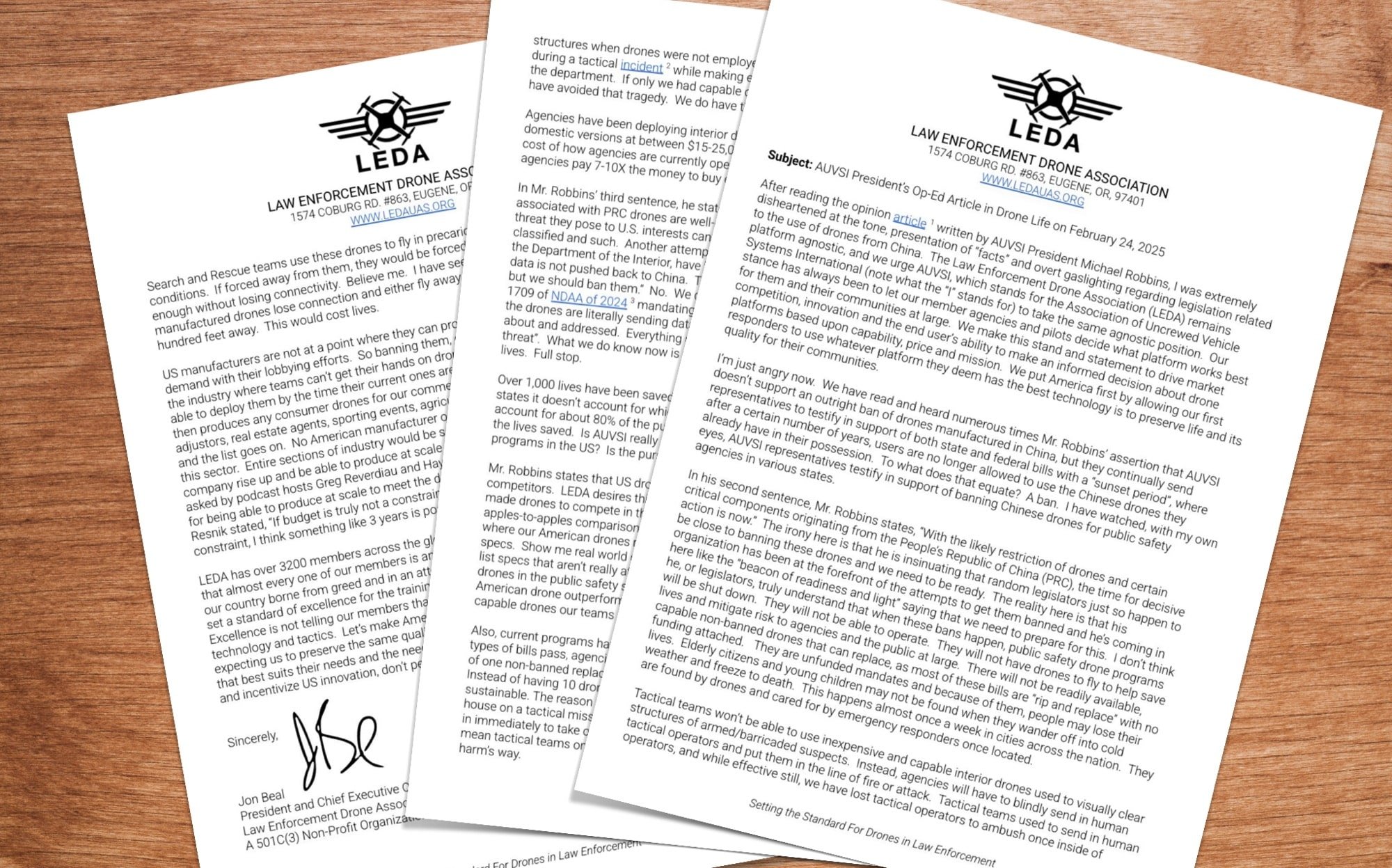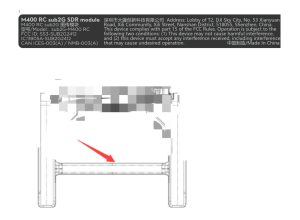LEDA Takes a Stand Against AUVSI’s Proposed Drone Restrictions
The Law Enforcement Drone Association (LEDA) has voiced strong opposition to the recent suggestions put forth by the Association for Uncrewed Vehicle Systems International (AUVSI), specifically from President and CEO Michael Robbins. AUVSI proposed immediate restrictions on drones and components imported from China, a position LEDA challenges vigorously.
LEDA’s President, Jon Beal, has criticized Robbins’ call for swift actions, arguing that such measures could significantly impair public safety operations and endanger lives. In a comprehensive letter, Beal advocates for a thoughtful approach, one that prioritizes community safety and operational effectiveness over what he describes as rash and fear-driven restrictions.
AUVSI’s Urgency for Action
In an opinion piece published on DroneLife, Robbins warned the U.S. drone industry to brace for tightening regulations on drones from China, referencing concerns highlighted by federal agencies such as the FBI and the Cybersecurity and Infrastructure Security Agency regarding vulnerabilities associated with Chinese-manufactured drones. Robbins pointed to Section 1709 of the FY2025 National Defense Authorization Act, which might permit the Federal Communications Commission (FCC) to classify Chinese drones as restricted technology, thereby limiting their allowed usage in the U.S.
He stressed that there’s an immediate need for decisive action to shift toward U.S. and allied-manufactured drones, warning of the risks to supply chain security if no action is taken.
LEDA’s Call for Thoughtfulness and Preparedness
LEDA, which consists of over 3,200 members globally, provided a more pragmatic view. Beal expressed frustration with AUVSI’s perceived fear-mongering and its demand for a blanket ban on PRC-manufactured drones, including popular models from DJI.
Stressing the importance of these drones in public safety, Beal noted that roughly 80% of the public safety drone market is dependent on Chinese drones. He cited data from the Drone Rescue Map that indicates over 1,000 lives have been saved using such drones, many likely being PRC models.
Beal questioned the rationale behind such a ban, asking, “What does that equate to? A ban would leave agencies incapable of effective operation, which could lead to lost lives during critical missions like search-and-rescue.”
The Financial Burden of Abrupt Restrictions

LEDA further highlighted the operational and financial strain abrupt bans would impose. Beal explained that PRC drones cost between $15,000 and $25,000 per unit, while alternatives manufactured in the U.S. could range between $105,000 and $250,000, making it highly challenging for law enforcement and emergency services to transition effectively without disrupting their operations.
As an illustrative case, Beal referred to the tragic 2007 incident involving LAPD Officer Randy Simmons, suggesting that the availability of drones could have changed the outcome. Moreover, he warned that U.S.-made drones often do not perform at the same level, revealing problems like connectivity loss over short ranges.
Assessing Security versus Practicality
While AUVSI emphasizes national security threats from PRC drones, LEDA has challenged these claims, citing the lack of definitive evidence of substantial data transfers back to China. Beal referenced studies, including one from the Department of the Interior, that found no indication of illicit data transmissions from these drones.
Furthermore, LEDA recognizes the necessity for secure supply chains but urges a measured transition period. Beal pointed out that Brinc’s CEO, Blake Resnik, proposed allowing three years for U.S. manufacturers to ramp up production to meet operational demand, which would enable agencies to maintain readiness during the transition.
Potential Market and Regulatory Changes
The proposed restrictions threaten to alter the landscape of the U.S. drone market, impacting various sectors reliant on affordable drone technologies, including film, agriculture, and construction. LEDA warns that widespread bans could trigger severe consequences across these industries.
The legislation foreshadowed in Section 1709 of the FY2025 NDAA is indicative of a moves to limit PRC technology overall. However, LEDA insists that regulators should consider the end-users’ practical needs when formulating policies. Beal encourages creating frameworks that incentivize innovation while ensuring operational flexibility.
The Competitive Nature of the Drone Industry
Despite advancements by companies such as Skydio and Brinc in the U.S. drone sector, Beal indicates that these often fall short in affordability and performance compared to their Chinese counterparts. The dominance of DJI, a Chinese firm, in the market is attributed to its provision of reliable, accessible drones tailored for emergency Services.
Although initiatives like AUVSI’s Partnership for Drone Competitiveness aim to mitigate reliance on PRC products, LEDA insists that such efforts should result in tangible improvements to public safety capabilities.
Addressing Security and Public Safety
LEDA’s communication brings to the forefront a significant debate within the U.S. drone community: the need for securing national interests while maintaining the efficacy of public safety operations. While AUVSI raises valid security issues, LEDA’s response foregrounds the life-saving potential of PRC drones and questions the availability of suitable alternatives.
The way ahead necessitates thoughtful discourse. Policymakers must provide clear timelines and allocate resources to facilitate a transition to allied drone technologies. In the meantime, LEDA asserted that outright bans on PRC drones—without comprehensive replacement strategies—could put lives at risk. As Beal states, “Foster and incentivize U.S. innovation, but don’t jeopardize community safety.”
For further reading, you can access the full LEDA letter addressed by Jon Beal, President and CEO of the Law Enforcement Drone Association.
Source: Original Article













